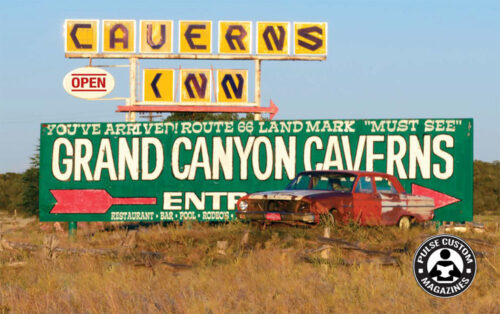Grand Canyon Caverns
This is the story of Grand Canyon Caverns, a unique tourist attraction along Route 66 about 63 miles east of Kingman, Arizona, just outside of Peach Springs. This story was written by Howard Sheldon.
Discovery of the Caverns
In 1927, a heavy rain widened the natural funnel-shaped opening to the upper level of an unknown system of caverns in western Arizona. A woodcutter for the Santa Fe Railroad by the name of Walter Peck found the entrance one evening on his way to a poker game at the nearby Yampai railroad siding house. The caverns were probably his only true winnings.
Walter took a gamble and named them Yampai Caverns. The caverns have changed names several times. Up until 1957 they were also known as the Coconino Caverns, then changed to Dinosaur Caverns; since 1962 they have been called the Grand Canyon Caverns.

The following morning, Walter and some friends brought ropes and lanterns with them to the new hole in the trail. They tied a rope around the waist of a local cowboy and lowered him into the hole. By the time the cowboy’s feet touched the floor of the hole, 150 feet of rope had been let out and he found himself in a very large and dark cavern.
Using a coal oil lantern, he began exploring; but the only thing that excited him was that he thought he had found a very rich vein of gold when the light picked up some sparkle in the rocks. Gathering up a sack full of samples, he tugged on the rope and was hauled to the surface. Upon reaching the surface, he quickly showed the samples and then told of finding the remains of two humans and part of a saddle at the 50-foot level. By the time the newspapers had finished with the story, the human remains were those of prehistoric cavemen and there was no mention of the saddle. Soon, scientists had come from the east to pick up and study the bones. While this was occurring, Walter purchased the property and the Caverns, preparing to mine the gold.
However, when Walter saw the assay reports on his gold mine, much to his dismay, no gold was found, only lots of iron oxide or rust! He had wagered his money on an empty funnel-shaped hole. But, being an entrepreneur, he soon came up with a solution. He would charge 25 cents to enter the Caverns where the “cavemen” had been found. He developed a very primitive elevator. Visitors were tied to a rope and lowered into the hole. Each visitor had to furnish their own light source. Upon reaching the floor of the hole the visitor could explore the caverns on their own. It would have been unwise to untie the rope and stray far, for if their light failed, the inexperienced explorer might not find the rope again!
In 1936, during the Great Depression, the Civilian Conservation Corp (CCC) work camps constructed a wooden staircase at the cavern entrance, then a series of wooden ladders for the descent. Finally, in 1957 a beautiful wooden swinging bridge was added to allow access to the Chapel of Ages. The trek is estimated to be approximately 15 stories of walking in and out if you were to compare it to a building.

The Caverns in 1962
After this phase of construction was completed, the price was increased to 50 cents, but now more than one person could enter the Caverns at a time. This was the only way in and out of the Caverns until 1962, when an elevator became operational. It had taken two years of blasting a shaft 210 feet deep plus an additional 18 months to install a modern-day elevator. The original natural entrance was then sealed off forever.
In 1962, in response to the Cuba missile crisis, the Federal government was looking for locations to stockpile provisions, as well as Fallout Shelters. The Grand Canyon Caverns were selected to house 2,000 people for an unknown period of time.

Visiting Grand Canyon Caverns
The caverns are 22 stories underground and are the third largest dry caverns in the world (largest in the USA). Those 22 stories are easily ascended and descended by elevator – no worry to run out of breath! Inside, the caverns are a perfect 65 degrees, 24 hours / 7 days a week / 365 days a year.
The huge caverns are large enough to hold a football field. They are dry. Nothing lives in them – no bats or insects. Inside, you’ll see rock formations, a mummified sloth and bobcat, and other great things including a light show.
Guided tours are offered daily. We have our regular tours (about an hour), our exploratory tour which is off trail and way down under (2 to 3 hours), and our Ghost Walk, an evening tour conducted by flashlight searching for paranormal ghost activities of people that have gone before us.

Unique Underground Motel Room
Also located in one of the caverns is the caverns suite. It is the largest, oldest, deepest motel in the world!
If you feel like arousing your senses, you can spend the night. It is a wonderful once in a lifetime experience.

